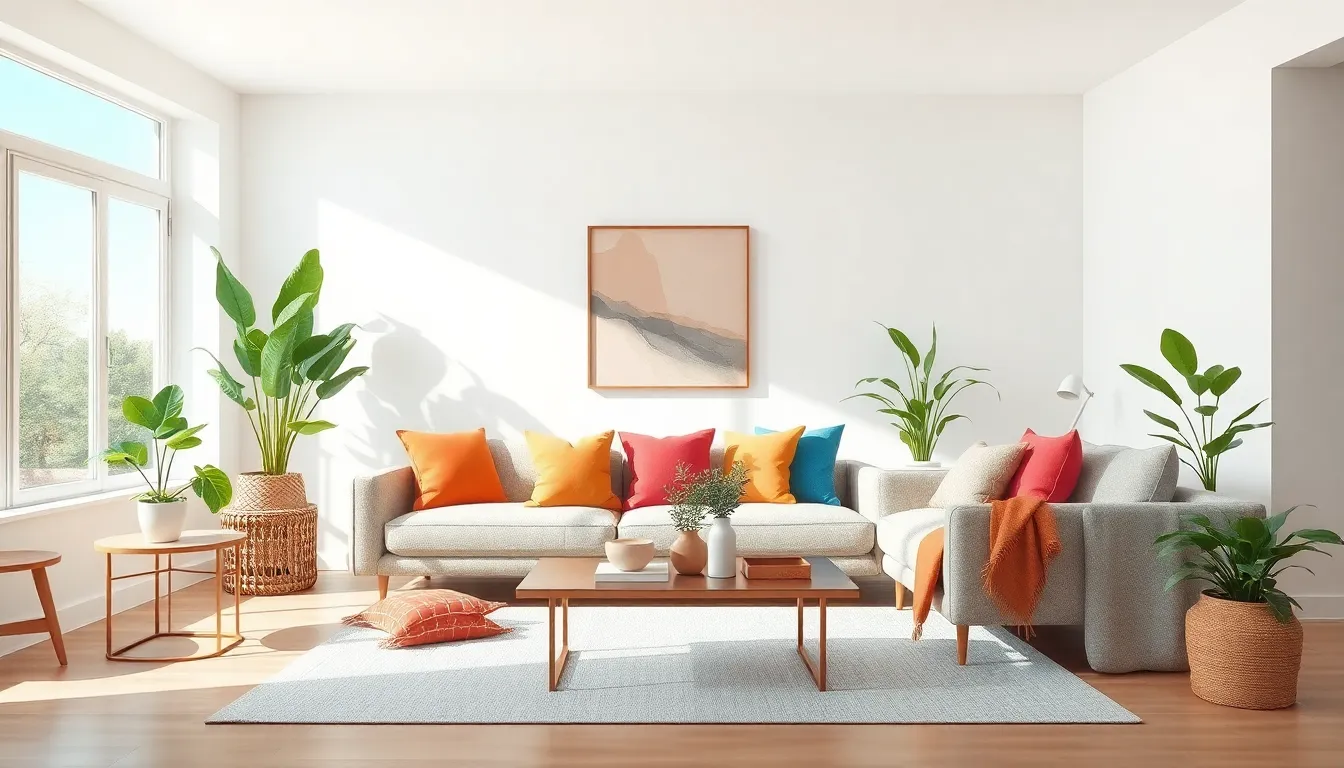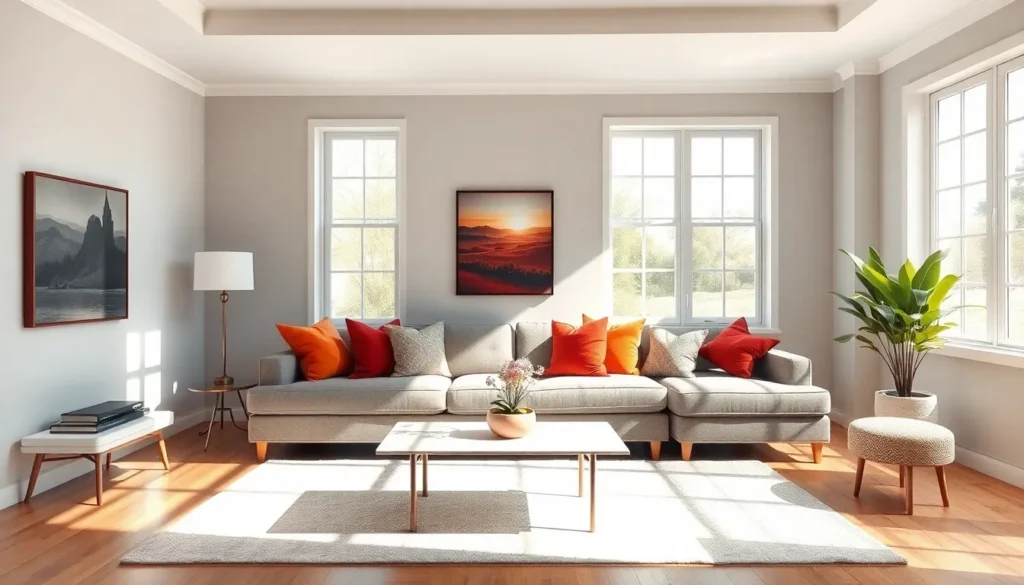Choosing the right paint color for a living room can feel like a high-stakes game of roulette. One wrong move, and that “soothing seafoam” could end up looking more like “toxic algae green.” But fear not! With a splash of creativity and a dash of strategy, transforming your living space into a cozy haven is just a brushstroke away.
From calming neutrals to bold statements, the right color can set the mood and reflect personality. Whether it’s a warm embrace or a refreshing burst of energy you’re after, this guide will help navigate the colorful world of living room paint. So grab your paint swatches and let’s dive into the hues that’ll make your living room the envy of all your friends—because let’s face it, who wouldn’t want to hang out in a space that’s as vibrant as their personality?
Table of Contents
TogglePopular Living Room Paint Colors
Choosing a paint color for a living room enhances its atmosphere. Popular color choices reflect styles and moods.
Warm Color Palettes
Warm color palettes create inviting spaces. Shades like soft reds, burnt oranges, and golden yellows stimulate energy. Living rooms with these hues often feel cozy and welcoming. Depending on the lighting, colors may appear different, so testing samples is essential. Think about how various lighting conditions affect warmth. Areas painted with warm tones encourage conversation and comfort, making them ideal for social gatherings.
Cool Color Palettes
Cool color palettes promote calm and serenity. Blues, greens, and soft purples provide a refreshing atmosphere. Light blues create spaciousness while deep greens evoke tranquility. Many people prefer these colors for a relaxing living environment. Combining different cool shades can create depth and interest. Accent pieces with contrasting colors can enhance the overall design. Spaces with cool tones often foster a peaceful ambiance, perfect for unwinding or reading.
Neutral Color Options
Neutral color options offer versatility and timeless appeal. Colors like beige, taupe, and soft grays act as a backdrop for other design elements. They blend seamlessly with various décor styles, allowing for easy updates. Neutrals can also make a room feel more expansive when paired with appropriate lighting. Adding textures through decor brings warmth to these understated shades. Spaces adorned with neutral colors maintain a sophisticated vibe while allowing personal expression through furnishings.
Factors to Consider When Choosing Paint Colors

Choosing paint colors for a living room involves several key factors that influence the overall outcome. Consider the following aspects to make an informed decision.
Room Size and Lighting
Room size significantly impacts color choice. Small rooms often benefit from lighter shades that create an illusion of space. Natural light affects how colors appear; north-facing rooms tend to showcase cooler tones, while south-facing rooms highlight warm colors. Assess the amount of light your living room receives during different times of the day. A well-lit room can accommodate richer, darker hues without overwhelming the space.
Existing Furniture and Décor
Existing furniture and décor play a crucial role in color selection. Analyze the dominant colors and materials of furniture before making a final choice. Choose paint that complements or contrasts with these elements to achieve a cohesive look. Accessories, artwork, and textile patterns should also be considered. Matching or harmonizing colors with these elements creates a unified aesthetic in the living space.
Personal Style and Preferences
Personal style defines the overall feel of a living room. Assess personal preferences for color temperatures; warm shades evoke coziness, while cool tones provide tranquility. Incorporating favorite colors into the palette ensures that the space feels tailored and reflecting individual taste. Exploring different color combinations can inspire creativity, resulting in a unique design that resonates with the homeowner’s lifestyle and personality.
Trends in Living Room Paint Colors
Current trends in living room paint colors reflect evolving aesthetics and individual preferences. Choices range widely, embodying both bold statements and subtle touches.
Bold and Vibrant Choices
Bold hues gain popularity in contemporary designs. Shades like deep reds, bright yellows, and vivid blues create dynamic focal points that draw attention. Such colors energize the space, making them ideal for artistic expression. Communities frequently choose these lively tones to inspire creativity and passion. Not only do bold colors enhance visual appeal, they also evoke strong emotions, contributing to an engaging atmosphere. People often explore accent walls in these daring shades, combining them effectively with softer tones for balance.
Soft and Subtle Shades
Soft shades provide a serene backdrop in living rooms. Pale blues, gentle greens, and muted grays promote tranquility and relaxation. Those who prefer a more understated look often gravitate toward these colors, as they foster a calming environment. Lighter hues enhance natural lighting, making spaces feel larger and airier. Subtle palettes blend effortlessly with a variety of furniture styles, ensuring versatility. Homeowners frequently incorporate soft tones to create an inviting ambiance that encourages comfort and peace. By layering textures and decor, these soft colors transition seamlessly between seasons.
Tips for Selecting the Right Color
Selecting the right color involves careful consideration of various factors. Utilizing paint samples can significantly impact decision-making.
Using Paint Samples
Using paint samples offers a practical way to visualize color choices. Sample sizes available in small containers allow easy testing on walls. Testing colors in different lighting conditions helps reveal their true appearance. Observing how colors interact with existing furniture aids in making cohesive choices. It’s important to evaluate samples over time, as colors may change throughout the day. Evaluating multiple shades side by side enhances the comparison process.
Considering Finishes and Sheens
Considering finishes and sheens plays a crucial role in achieving desired aesthetics. Different finishes, such as matte, eggshell, satin, and gloss, dramatically affect how colors appear. Matte finishes hide imperfections and create a smooth look, while gloss adds shine and reflectivity. Satin offers a balance between the two, providing subtle sheen without excessive glare. Choosing the right finish also depends on functionality; high-traffic areas benefit from durable, easy-to-clean surfaces. Understanding how sheens interact with light can enhance the overall effect of color in the living room.
Choosing the right paint color for a living room is a transformative process that can truly enhance the space. By considering personal style and the desired atmosphere, anyone can find the perfect hue that resonates with their vision.
Whether opting for warm tones that invite conversation or cool shades that foster relaxation, the possibilities are endless. Incorporating current trends and timeless neutrals allows for a dynamic yet cohesive look.
Ultimately, the right paint color not only reflects individual taste but also creates an environment that feels like home. With thoughtful selection and a bit of creativity, a living room can become a vibrant and welcoming haven for all.






